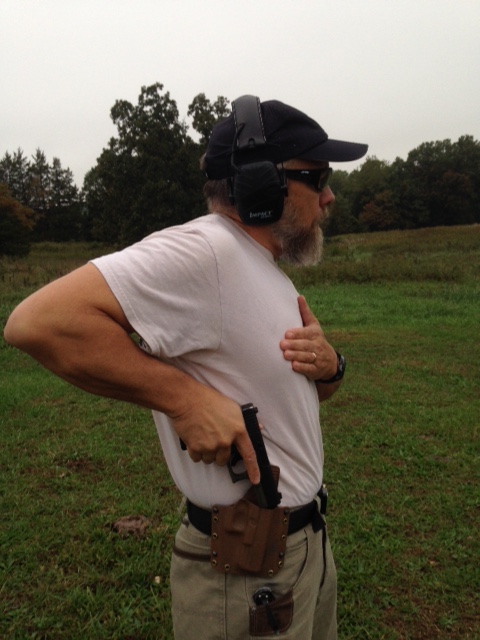“Holstering a pistol is the most dangerous thing we do.”

I believe I was told this at the first pistol class I ever took, and some form of this warning has been repeated at nearly every class I have participated in since. There is certainly plenty of truth in it; even a cursory internet search will yield dozens of gruesome photos and videos of people shooting themselves in the foot, thigh, and, perhaps most dangerously, the groin, as they holster their pistols.
Not long ago, nearly all the big experts advocated learning to holster the pistol without looking toward the leather. These experts emphasized the need to keep your eyes up, in order to be aware of your surroundings. A new threat may emerge, or the threat you thought had backed down may take advantage of your holster fumble to attack again.
This practice has fallen out of favor with the newest crop of influential firearms instructors, who are teaching the opposite- Do look at your holster as you replace your piece. Men like Greg Ellefritz and John Correia, and even some of the older guys (for instance, Gabe Suarez), have jumped on the “look your gun into the holster” band wagon. Suarez lays out perhaps the most cogent and authoritative argument for this, which you can read here. http://blog.suarezinternational.com/2017/02/looking-at-the-holster.html?cid=6a0133ec985af6970b01b8d2618563970c#comment-6a0133ec985af6970b01b8d2618563970c
The arguments he makes is simple and powerful: Holstering is dangerous; you have no business putting your gun away if there is still a possibility of a threat any way. The reason cops were formerly taught reholstering without looking, was so they could handcuff a perp, but the new doctrine calls for the suspect to be held at gun point until back up arrives. I will discuss these points one at a time.
1 Holstering is dangerous. This is quite true, and more so than it was before 1981, when the Glock 17 with its light trigger and lack of an external safety was invented. The danger has grown with the advent of widespread concealed carry laws, which have spawned a plethora of holster types, carry locations, and methods, nearly all of which are less safe than the old, reliable, outside-the-belt-strong-side method that used to be the norm. The other side effect is that large numbers of people are carrying guns, the vast majority of which have less training even than the small amount that police are required to undergo. Added to that is the internet, which broadcasts the photos of negligent discharges, making them seem even more common than they actually are.
2 You have no business putting your gun away if there is still a possibility of a threat. This makes a lot of sense, as long as your problems remains simple, back up is only minutes away and it is always obvious that you are the good guy.
Imagine that you are unfortunate enough to be present during a classic spree shooting at your local shopping mall. You intervene, and the perpetrator, when confronted with an armed resistance, surrenders. You hold him at gunpoint while you wait for the police to arrive. Bear in mind they are responding to a shooting in progress, so when they see you holding the prep at gunpoint, they see a man with a gun holding a hostage, not a citizen stopping a homicidal maniac. Here you are faced with two threats: the first is a homicidal maniac, who may choose to jump back in the fight; the second is the responding officer, who may, with reasonable justification, perceive you as the gunman. Sounds like a great time to deliberately reholster your pistol, while keeping your eyes on the threat.
His third argument is that cops do not need to reholster to cuff their collar, all they need to do is hold the felon at gunpoint until backup arrives. To this, I can only say that I wish every cop in America worked in an environment where backup is only minutes away. Unfortunately, many serve in departments where backup is too far away for this to be practical.
As in many other respects, the Hojutsu answer to “should I look my gun into the holster?” is not “always”, or “never”, but “It depends”.
Are there times and places for that deep concealment holster that takes two hands and two eyes to use? Absolutely, but whenever possible we should use a pistol holster combination that can be holstered safely, even blind. We also train, using a blue gun to practice our manipulations, until we can perform them safely, even when cold, wet, tired, hungry, scared, and wounded.
In the Hojutsu Ry discipline, students learn to holster without looking. I get it, sometimes we all need to look at our holster, and you are not “wrong” if you do. When something doesn’t seem right, you look, clear whatever is the obstruction, and holster the gun, but we want to cultivate the ability to transition seamlessly and fluidly from weapon to open handed technique and back again as the situation calls for
I am reminded of something Jeff Cooper wrote in The Art Of the Rifle:
“A marksman is one who can make his weapon do what it was designed to do…
A master marksman is one who can shoot up to his rifle”
The goal of Hojutsu is not only to teach people to make the weapon do what it was designed to do, but to inspire them to go beyond that, and work toward mastering their weapon system, working to be able to do all that the pistol is capable of.
A small part of that goal of mastery is the ability to perform crucial manipulations, including reholstering, without looking.
To learn more about Hojutsu Ryu go to http://www.hojutsu.com/